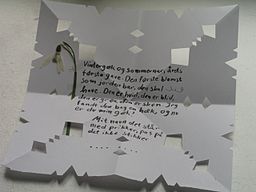
A gækkebrev with a vintergæk (snowdrop) included.
While Easter is celebrated in many countries throughout
verden (the world), there is one Easter tradition which only exists in Denmark: the sending of
gækkebreve.
Brev is ’letter’ (snail mail). If you lived in the 19th century and felt like asking if that bell-ringing jester in front of your table were pulling your leg or something, you might have said
Driver du gæk med mig? A
gækkebrev, in other words, is a letter that tricks you.
A gækkebrev is typically made by a child in the days preceding Easter. She’ll fold a piece of paper and then use a saks (pair of scissors) to cut out small triangles, circles etc. from the folded edge. When unfolded, the paper is nicely covered with symmetric rows of holes, almost like a piece of lace. The child then writes – or is helped to write – a message on the parts that are still whole. It may be a small poem, or some nonsense phrases, and the ending often contains the words mit navn det står med prikker, ”my name it stands with dots”. Finally she ”spells” her name with dots, one for each letter: • • • •
The gækkebrev is then sent to a friend or relative, who is now supposed to guess the identity of the sender. If he fails, he’ll have to give her a påskeæg (Easter egg). If he does guess who wrote the dots, however, she’s the one to give him a chocolate egg for Easter…
Sometimes adults too take their time to make gækkebreve, which may turn out as real works of art. The fun part – beside cutting the patterns and making a decent verse – is, of course, the attempt to fool the receiver. When I was a child, my parents and I sometimes made a relative who was about to go abroad mail a gækkebrev for us. ”Jeez, an anonymous letter with a machine-typed envelope stamped in Hong Kong – who on earth could that be?”
One of the most common gækkebrev verses runs like this:
En vintergæk, en sommernar,
en fugl foruden vinger,
en lille ven, som har dig kær,
en kærlig hilsen bringer.
A snowdrop (a kind of white flower found in early spring; it may also be translated as ”winter jester”), a summer jester,
a bird without wings,
a little friend, who’s fond of you,
a loving greeting brings.





